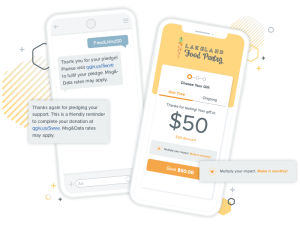Do you want a more reliable flow of income?
Does your charity ever have slow donation periods?
Do you want to make budgeting easier?
Do you want to raise more money?
If you answered “yes” to any of those questions (and seriously, who wouldn’t?!), you might want to consider setting up options for recurring donations. Recurring donations are a wonderful way your donors can show long-term support for your organization.
- What are recurring donations?
- What are the benefits of recurring donations?
- What is the average recurring donation?
- Why are recurring donations better than one-time donations?
- Will my supporters actually make recurring donations?
- How do you ask for recurring donations?

1. So, what are recurring donations, exactly?
When a donor sets up a recurring donation, they choose to give a pre-determined amount of money on a regular basis. Many people like to give monthly, bi-monthly, or yearly, but they can give as frequently as they’d like.
2. What are the benefits of recurring donations?
For donors, recurring options help them manage their charitable giving without worrying about missing a payment. Charities also benefit; when donors opt to set up recurring donations, charities can adjust their ask strategies and campaigns accordingly. More long-term donations mean fewer reminders, brochures, and time-consuming e-mails that are associated with one-time donations. Instead, they can focus on the ever-important emotional bond between them and their supporters by keeping them involved in the organization’s narrative.
There are more financial advantages, too. Recurring donations can help keep revenue flow stable during slow donation periods. Recurring donors typically donate more than their one-time counterparts, too!
3. What is the average recurring donation?
The average value of a monthly donation in 2023 is $38 each month according to Cybergrants. While that doesn’t seem like a lot, the value of the gift comes from the fact it’s given twelve times in a year. This means that a monthly gift of $38 has a $456 potential value each year. That’s easily double the one-time gift’s value of $120.
4. Why are recurring donations better than one-time donations?
For donors, recurring options help them manage their charitable giving without worrying about missing a payment. Charities also benefit; when donors opt to set up recurring donations, charities can adjust their ask strategies and campaigns accordingly. More long-term donations mean fewer reminders, brochures, and time-consuming e-mails that are associated with one-time donations. Instead, they can focus on the ever-important emotional bond between them and their supporters by keeping them involved in the organization’s narrative.
There are more financial advantages, too. Recurring donations can help keep revenue flow stable during slow donation periods. Recurring donors typically donate more than their one-time counterparts, too!
5. Will My Supporters Actually Use Recurring Donations?
Yes! Recurring options are increasingly popular among donors. In fact, the 2023 eNonprofit Benchmarks study by NTEN says “while one-time giving declined by 12%, monthly giving rose by 11%.” “
So are recurring donations right for you? If you want to earn more money, focus more energy on donor retention, build a stable revenue flow, or make financial planning easier, they’re definitely something to consider.
6. How do you ask for recurring donations?
Come right out and ask in appeals!
When it comes to asking your supporters to give to your nonprofit on a recurring basis, our first piece of advice is to ask them to support you with a recurring gift. Just come right out and ask in appeals! When crafting your appeals, ask supporters to give to you on a monthly basis. Explain how their contributions will help and what you hope to accomplish with these recurring donations.
One important caveat is not to expect large donations from a recurring appeal. A donor is unlikely to provide you with $500/month in support (but it would be great if they did). Instead, keep expectations low. Remember that the average monthly gift is $25. You can earn more than that from donors, but $25 is a great starting point and earns you $300 every twelve months.
Set up a recurring nudge or modal on your online donation form
Another way you can ask for recurring donations is directly on your online donation form. You just add a recurring nudge or modal to your form to inspire one-time donors to give on a recurring basis instead! A recurring nudge is a tiny blurb on your donation form that asks in a passive way for recurring gifts. The recurring modal is a bit more direct in that it pops up before a one-time donation is completed and asks the one-time donor to convert their one-time gift into a recurring gift instead. You can customize the language of the recurring gift prompts to match your organization and even spell out how recurring gifts will be used. This move can inspire donors to give on a recurring basis rather than making a one-time gift.
Enable giving plans on your online donation form
Our last suggestion for asking for recurring giving is to enable giving plans on your online donation form. With giving plans, donors can choose to make a recurring gift at a specific duration, frequency, and total gift amount. It takes all the guesswork out of making a recurring gift for the donor while you earn more from the regular installments that are made by donors.
Giving plans can be customized with different amounts and giving frequencies. You can also link gifts to specific goals and initiatives to create impact statements for donors. Plus, you can show donors exactly how much they’ll end up giving over time.
One important caveat with giving plans is that they have an end date. Unlike an open-ended recurring donation, you’ll need to keep an eye open for when donors’ giving plans expire. That way, you can invite them to make another recurring gift via the giving plan.
Final thoughts
Are recurring donations right for your nonprofit organization? If you’re looking for more sustainable revenue, chances are they’re perfect for your organization. With recurring donations, you get a more reliable flow of income to help stop slow donation periods. You also are generating more sustainable revenue from donors giving to your nonprofit on a regular basis. Not only that, but recurring donors give more throughout the year than one-time donors on average and also give more throughout their lifetime. Capturing recurring donors should be high on every nonprofit’s list of priorities because it makes it easier to stay funded when you have a reliable source of revenue coming in.









